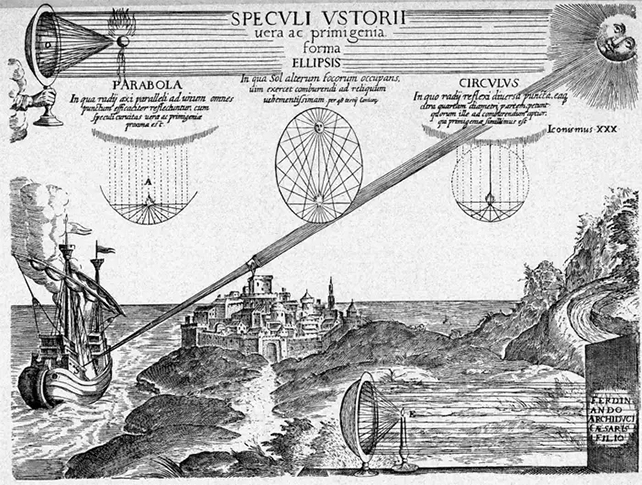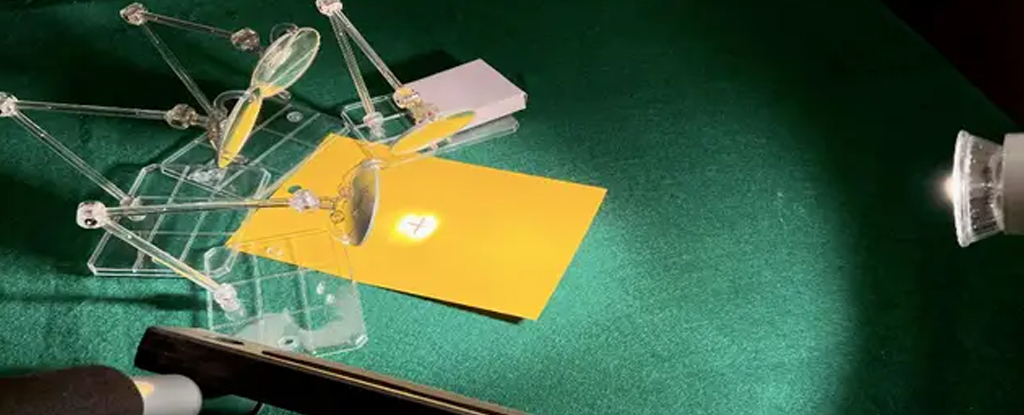Legends about the ingenuity of the Greek inventor and mathematician Archimedes were so powerful that for centuries, many scholars have believed he was able to use mirrors to set Roman ships alight more than 2,000 years ago.
A Canadian middle schooler, Brenden Sener, designed a science-fair project to see whether such a feat was possible with a miniature version of the death ray.
Though he wasn’t trying to set anything on fire, he found that his setup – which included heat lamps and mirrors – did significantly increase the temperature of the target.
Based on the results of his project, the 13-year-old concluded that Archimedes may have been onto something.
“If it was scaled up and with a strong enough heat source, it would definitely be possible,” he told Business Insider.
Replicating the siege of Syracuse
Sener first became interested in the famous mathematician after seeing the Archimedes screw in a documentary. He made an earlier science-fair project based on that device, which is often used in irrigation.
“Due to Archimedes being such an amazing inventor, I decided to research more of his inventions,” he said. That’s when he found the so-called death ray.
During the siege of Syracuse between 214 and 212 BC, a Roman general, Marcus Claudius Marcellus, attempted to invade the island of Sicily.
A historian in the 12th Century wrote that by “tilting a kind of mirror toward the Sun,” Archimedes “burned up the whole Roman fleet.” The writer, Joannes Zonaras, based the description on an earlier historian’s writings from a couple hundred years after the siege.
In his scaled-down model, Sener used heating lamps to represent the Sun. Small concave mirrors reflected the light onto a piece of cardboard with an ‘X’ marking the target.
“It was just a smaller version of as close as I could get it in real life,” he said.
An infrared thermometer measured the temperature increase each time Sener added a mirror. With a 100-watt bulb, the first mirror warmed the target by about 46 degrees Fahrenheit.
Adding a second and third mirror increased the temperature by between 38 and 40 degrees, while the fourth mirror raised it by 50 degrees to 128 degrees Fahrenheit.
Sener surmised that the Archimedes death ray wasn’t impossible if it had used many more mirrors and a hotter heat source.
A long history of death-ray attempts
Many others have tried to recreate the death ray with varying levels of success.
Most recently, the TV show Mythbusters took on Archimedes’ death ray three times and never managed to make it work. In 2005, an MIT professor ignited a wooden boat with the technique, but a second attempt failed.
But the death ray has captured imaginations for centuries.
The philosopher René Descartes found it implausible in 1637. More than 100 years later, the scholar Athanasius Kircher went to Syracuse to work out how distant the Roman boats would have been. In 1747, Georges-Louis Leclerc, Comte de Buffon, who was a French naturalist, attempted his own experiment with mirrors.
In 1973, an engineer, Ioannis Sakkas, decided the story was plausible because he used bronze-coated mirrors to set tar-covered wood on fire in just a couple of minutes.
But as Sener pointed out, moving boats are much more difficult targets. Cloud cover, distance from the shore, and wetness of the wood could all affect the technique’s effectiveness.

Scientists and historians have pointed out that Archimedes had other weapons at his disposal that were less finicky and more cost-effective. Some have suggested steam cannons or incendiary mixtures as ways of burning the Romans’ ships.
The Greeks may also have used mirrors to dazzle the sailors. The reflective surfaces and fiery boats could have become conflated in the ensuing centuries, possibly creating the myth of a death ray.
Whatever happened with Archimedes, Sener is most proud of the award he won from the London Public Library for inspiring students’ interest in science and technology.
“I really appreciated that,” he said.
This article was originally published by Business Insider.
More from Business Insider:





